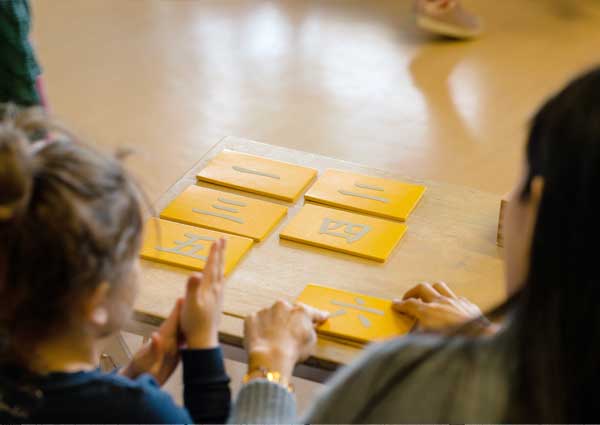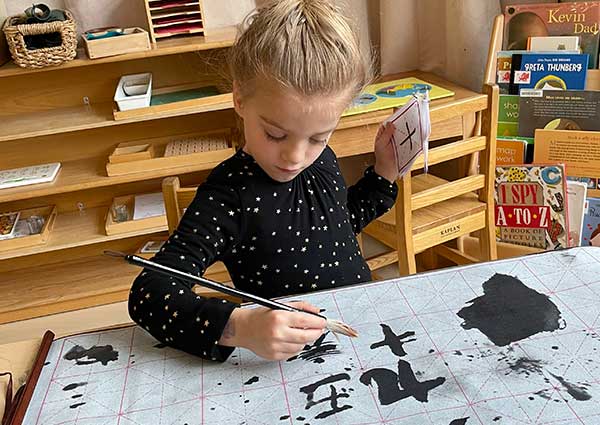Trilingual Montessori Language Program
Exclusively Available at Battery Park Montessori!
As Maria Montessori’s observations and current brain research has shown, children’s sensitive period to language is from 0 to 6 years old. Their brains are open to absorbing new information of all kinds – especially new languages.
Our trilingual language program complements a young child’s natural predisposition to new sounds and rhythms. At Battery Park Montessori, we expose our children to both Mandarin and Spanish with Montessori trained, native language speaking teachers in each classroom throughout the day, every day. In this way, all of our students benefit from both immersive instruction and daily exposure to Mandarin and Spanish.
With teachers in all languages present, children are encouraged to interact and express themselves in all languages on a daily basis. Children learn from Montessori-trained teachers who are native Spanish and Mandarin speakers and who fully engage the children in daily conversations, singing, and vocabulary. Lesson content in math, geography, practical life, and more are also delivered in Mandarin and Spanish in the form of classical Montessori education.
Why Spanish and Mandarin?
Spanish and Mandarin are the most spoken languages in the world. In exposing our children to Spanish and Mandarin, we hope to foster their global appreciation for and understanding of their peers and neighbors worldwide.
We also expose our children to Spanish and Mandarin to help them with other disciplines, such as literacy and math, and to further develop their executive function:

To learn a language, one must learn to decode that language, and decoding, within itself, is a universally beneficial and transferable skill - especially with regards to literacy and comprehension. For instance, learning Spanish can reveal the Latin roots for English words making it easier for children to decode and understand English text and vocabulary.
Research has shown that learning Mandarin, particularly distinguishing its four tones for the same basic sound, develops the brain’s temporal lobes which has a positive effect on the way non-language content, such as math, is processed.
Learning languages encourages children to rely on their working memory and mental flexibility. Memorizing songs, seeing patterns in language, understanding the relationships between words within one language and across others... this is all helpful in developing the brain’s executive function.
What if my child does not speak Mandarin and/or Spanish?
Both native and non-native speakers benefit equally from our language program: Native speakers not only refine their language skill, but develop self-esteem and leadership, plus greater enthusiasm about the language as they see their non-native peers learning. Non-native speakers will have exposure to new sounds and their meanings during an ideal developmental period for language acquisition. Early exposure to a new language helps develop a number of skills and broadens a child’s horizons in many ways.
What if my child already speaks two other languages not spoken at Battery Park Montessori? Will my child be confused with the introduction of Spanish and Mandarin?
No. Much research has actually pointed to the opposite. Since children already have a subset of sounds from the learning of other languages and have been exposed to code-switching, or the changing of language(s) depending on the situation and the person to whom you are speaking with, these children already come in with skills that prepare them to take on other languages. Additionally, these children are already developing metalinguistic awareness, or the ability to understand the patterns in how language works, thus making it easier for them to pick up other languages.
We encourage families to continue speaking with their children in these other languages. Learning more than one language (any language) at such a young age builds a reservoir of skills that could be tapped into for different reasons both in the short and long terms. Studies have shown that the more languages a person knows, the greater the neurological “reserves” are in the event they are needed.
How do the language teachers approach children with regards to language instruction?
We use an immersive approach to teaching languages guided by the “one-parent/one-language” theory. Throughout the day, our teachers remain in their native tongue with exceptions made for teaching English literacy and for when a child may need some support in the target language by using the language they know best.
Children are evenly exposed to our target languages since teachers rotate their roles in the classroom throughout the week. For example, teachers alternate who is the peacekeeper, lesson-giver, and bathroom support person so that children experience the language authentically and in various contexts.
What methods do you use to teach languages in the classroom?
Besides presenting all classical Montessori materials in our target languages, we may use teacher-made materials that are in line with the Montessori philosophy and align with our Identity, Diversity, Equity and Anti-racism curriculum topics.
In addition to materials, the teachers sing a lot of songs – some of which have been translated from English so that the melody is the same and children have a general sense of what the song is about. We also use sign language for a few words to aid the child in visually and kinesthetically understanding their meaning. In addition, we have a list of common grace and courtesy words that all teachers – English teachers included – use throughout the day. Although our target language teachers avoid speaking in English, we do encourage our English teachers to model language learning in front of the children. Their efforts to speak Mandarin and Spanish are observed by our little ones and indirectly support them in taking linguistic risks.
Family Resources
Books
- The Cognitive Neuroscience of Second Language Acquisition by Marianne Gullberg and Peter Indefrey
- Principles and Practice in Second Language Acquisition, by Stephen D. Krashen, 1982
Articles
- Bilingual Education: 6 Potential Brain Benefits, by Anna Kamenetz, NPREd, Nov 29 2016
- Chinese Language Learning in Early Grades, published by Asia Society
- Brain Benefits of Multilingualism, Academy of Finland, ScienceDaily, Nov 26 2009



